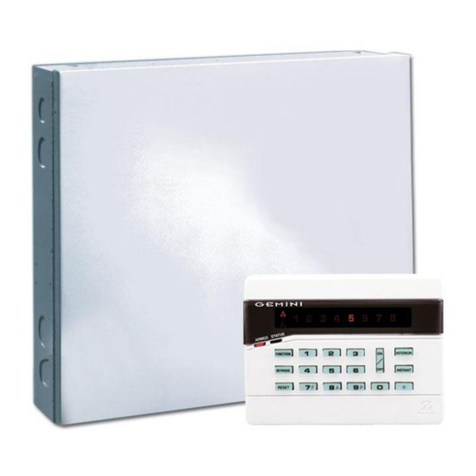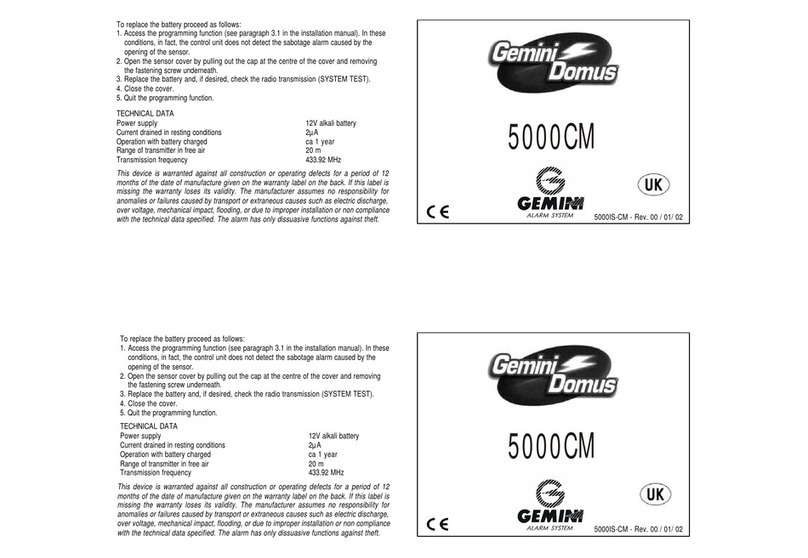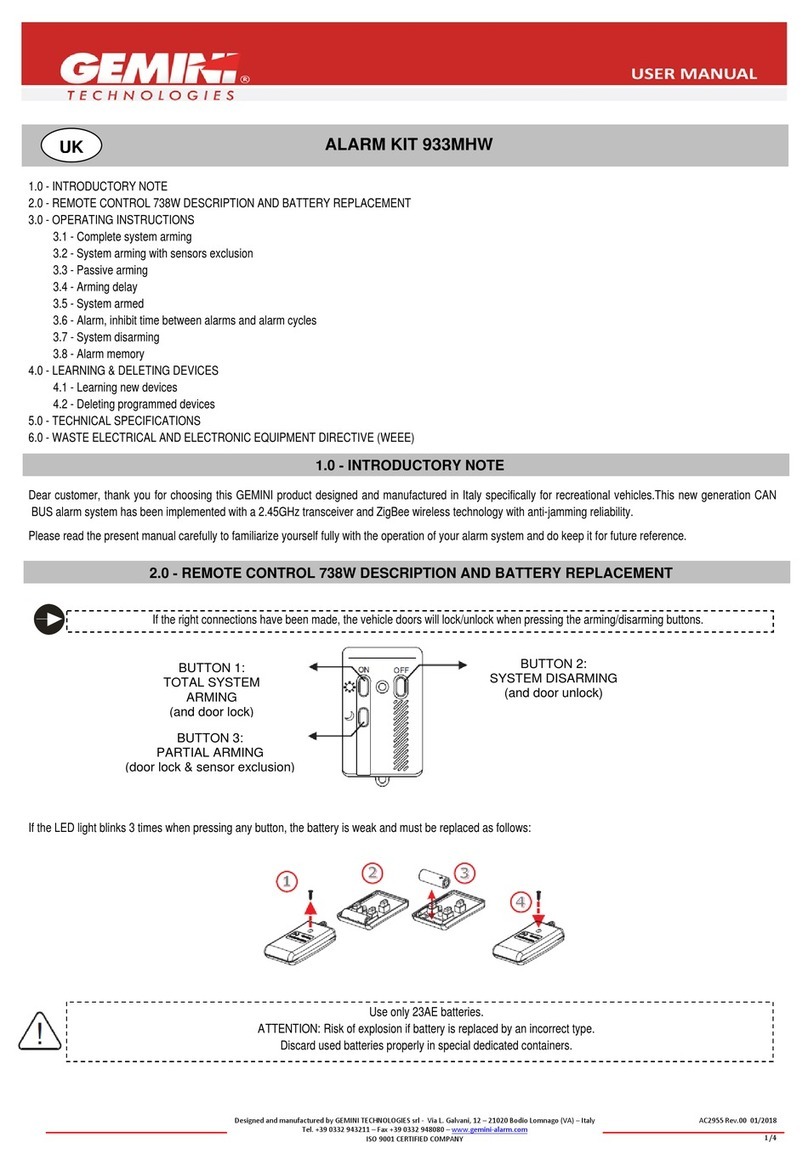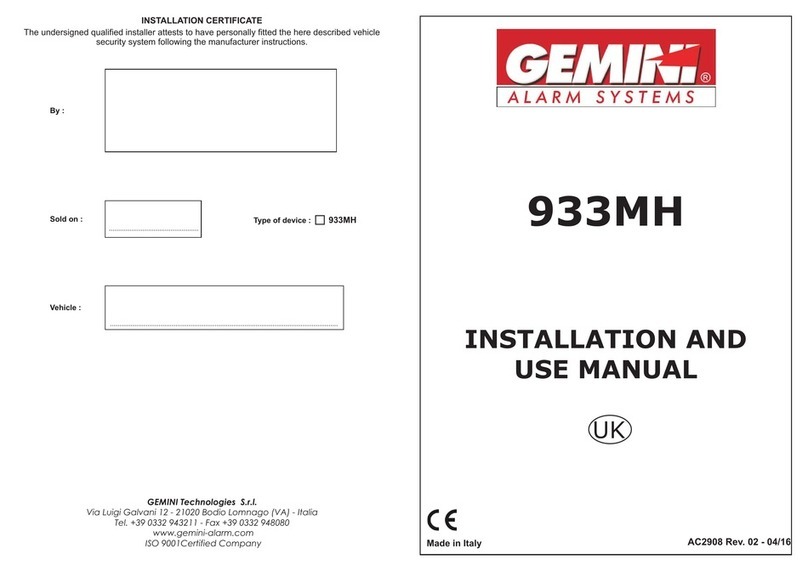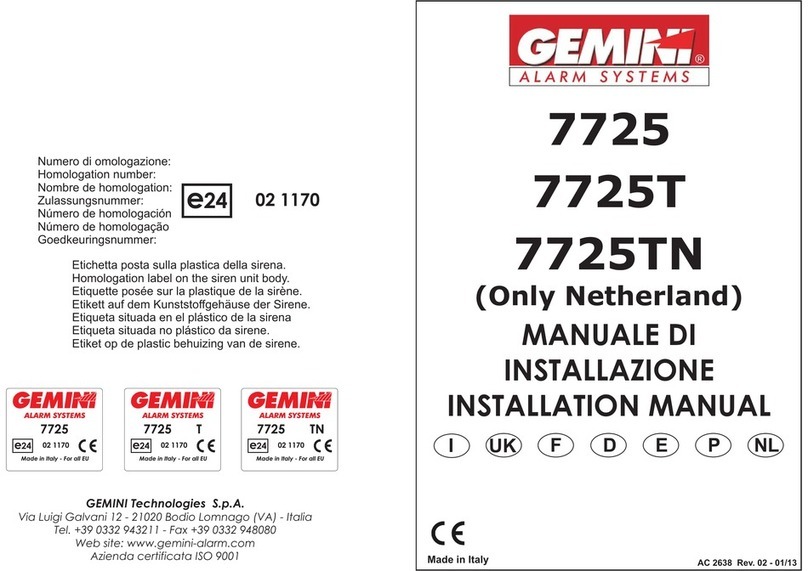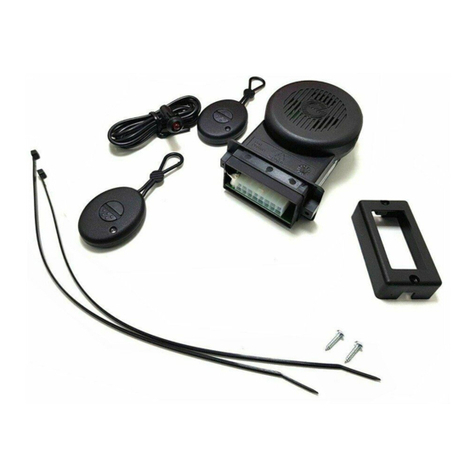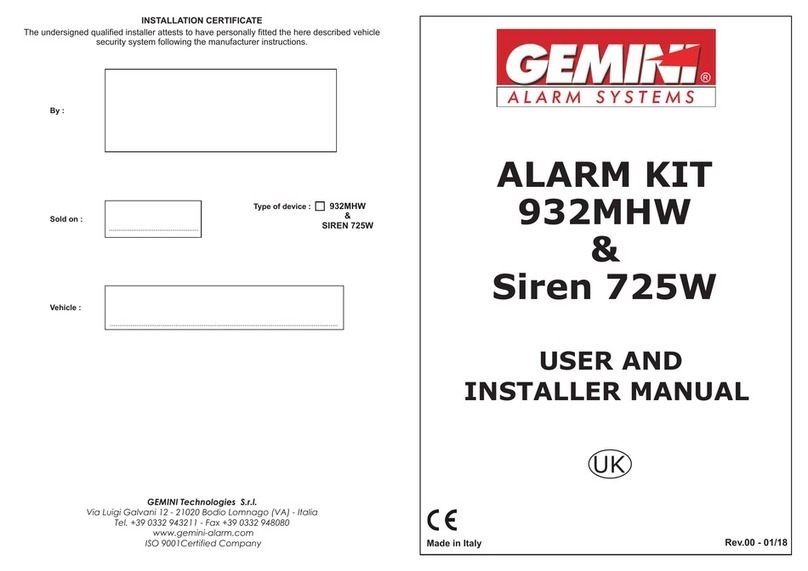
PAGE 02
1.0 - PRELIMINARY ADVICE
Dear Customer, th
.
same as 933 without self-powered battery.
:
GEMINI 932:
e present manual illustrates the most fully featured alarm system; not all functions,
electrical connections etc. will therefore apply to all models.
Before installing, identify your alarm model and refer to it for the correct instructions
The following signs, intended for the installer or the user, indicate particular functions or connections
as follows
USER MANUAL - PAGE 03
TABLE OF CONTENTS
For the installer.
This sign indicates that the system will work according to the connections and the
programming selected or it simply provides useful installation tips.
!
For the user.
This sign highlights useful information.
UK
1.0
2.0
4.0
5.0
6.0
7.0
8.0
14.0
15
16.0
17.0
- PRELIMINARY ADVICE.............................................................................................
- OPERATING DESCRIPTION.....................................................................................
2.1 - Complete system arming..........................................................................................
2.2 - System arming with sensor and comfort control exclusion.......................................
2.3 - Passive arming.........................................................................................................
2.4 - Arming delay.............................................................................................................
2.5 - System armed..........................................................................................................
2.6 - Alarm, neutral time between alarms and alarm cycles.............................................
2.7 - System disarming.....................................................................................................
2.8 - Emergency disarming by electronic key...................................................................
2.9 - Alarm memory...........................................................................................................
WARRANTY CONDITIONS ...................................
- WASTE ELECTRICAL AND ELECTRONIC EQUIPMENT (WEEE) DIRECTIVE.......
- PIN-OUT TABLES.......................................................................................................
5.1 - 20-pin connector.......................................................................................................
5.2 - 8-pin connector.........................................................................................................
- WIRING DIAGRAM.....................................................................................................
-C ............
..........................................................................................
..........................................................
7.3 - Connection to Hazard light switch............................................................................
- CONNECTIONS TO ARM/DISARM THE SYSTEM..................................................
.........................
......................................................
8.3 - Connections to turn indicators..................................................................................
8.4 - Combination connection...........................................................................................
SYSTEM PROGRAMMING.............. ....................................
.....................................................................................
.........................................................................
11.3 - Passive arming.......................................................................................................
11.4 - Enabling 5) ........................................................................
11.5 - Door switch polarity selection.................................................................................
11.6 - Optical pulse signal/self-powered siren.
11.7 - Negative output s ..................
..............................................
ADDING NEW DEVICES..........................................................................................
- DELETING PROGRAMMED DEVICES...................................................................
..........................................................
..........................................................................
..........................................................................................
- SYSTEM RESET......................................................................................................
- TECHNICAL SPECIFICATIONS...............................................................................
USER MANUAL
INSTALLER MANUAL
3.0
9.0
10.0
11.0
12.0
13.0
.0
- .....................................................
ONNECTION FOR TURN SIGNALS ACTIVATION......................................
7.1 - Standard connections.....
7.2 - Connections for vehicles with separate lines..
8.1 - Connections and management via CAN BUS line..........................
8.2 - Connections to door lock motor unit...................
- VEHICLE CODE PROGRAMMING............................................................................
- LEARNING OF TURN INDICATORS FLASHES......................................................
- ....................................
11.1 - Optical signals...................
11.2 - Acoustic signals.............................
of siren (art. 772 output
.................................................................
election (during alarm) for horn or additional siren...
- SYSTEM PROGRAMMING EXAMPLE......................
-
- ULTRASONIC VOLUMETRIC PROTECTION
15.1 - Connections and positioning........
15.2 - Sensor adjustment........
PAGE 03
PAGE 03
PAGE 03
PAGE 03
PAGE 03
PAGE 03
PAGE 04
PAGE 04
PAGE 04
PAGE 04
PAGE 04
PAGE 05
PAGE 05
PAGE 06
PAGE 06
PAGE 06
PAGE 07
PAGE 08
PAGE 08
PAGE 12
PAGE 12
PAGE 12
PAGE 12
PAGE 12
PAGE 12
PAGE 13
PAGE 13
PAGE 14
PAGE 15
PAGE 16
PAGE 16
PAGE 16
PAGE 16
PAGE 17
PAGE 08
PAGE 08
PAGE 09
PAGE 09
PAGE 09
PAGE 09
PAGE 09
PAGE 10
PAGE 11
PAGE 12
2.0 - OPERATING DESCRIPTION
Exclusion of sensors and comfort feature is bound to each single arming
cycle.
USER MANUAL
2.1 - COMPLETE SYSTEM ARMING
2.2 - SYSTEM ARMING WITH SENSOR AND COMFORT CONTROL EXCLUSION
Press the lock button on the
).
ake sure the system is disarmed and ignition turned “OFF”.
.
.
.
vehicle original remote control; system arming is confirmed by a siren
chirp (if feature has been configured) and a flash of the turn indicators.
The system has a 30” arming delay (indicated by the LED turned ON steady
To arm the system without activating the internal volumetric protection and comfort function proceed
as follows:
•M
• Show the electronic key to its receptacle; the LED will give out a quick flash
• Close all vehicle doors and press the lock button on the original remote control
• System arming is confirmed by the standard optical/acoustic signals
2.3-PA
If this function is configured, the system passively arms approx. 60” after ignition switch off and after
the last door is closed.
System activation is confirmed by the standard optical/acoustic signals.
SSIVE ARMING
If passive arming is activated, functioning of internal sensors and comfort output
(automatic window roll-up) are excluded.
Opening a door 60” before the system is armed causes the procedure to interrupt; it is
resumed once the door is closed.
2.4 - ARMING DELAY
Before the system is fully armed, there is a 30” arming delay, signalled by the LED turned ON steady, to
.exit the vehicle without triggering an alarm
